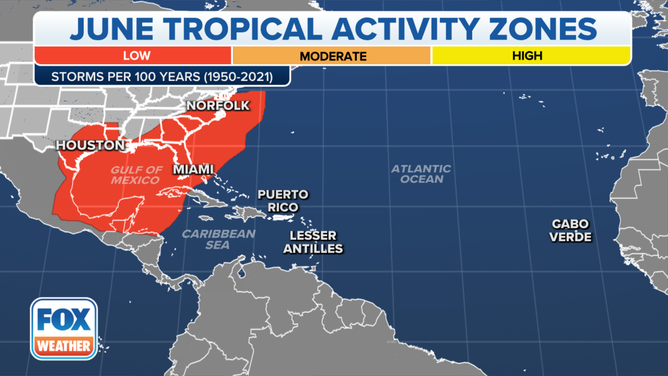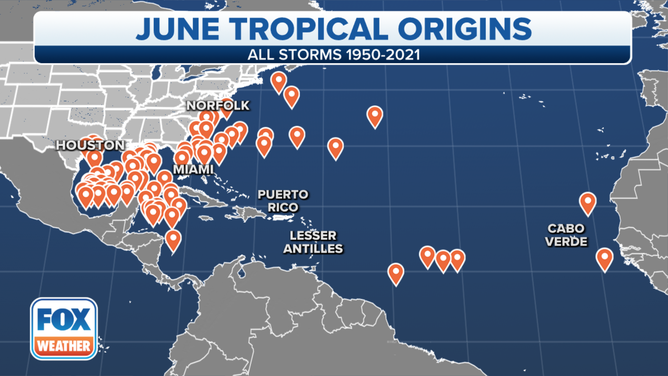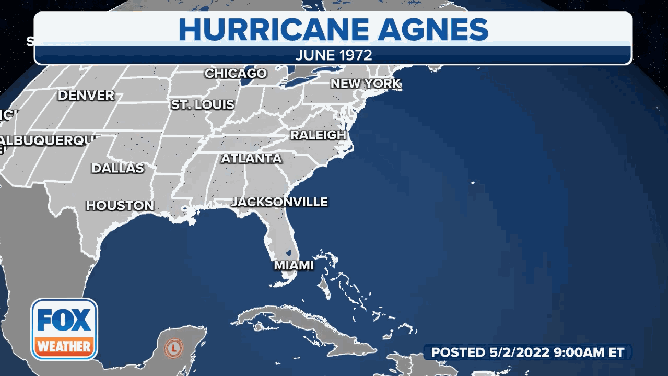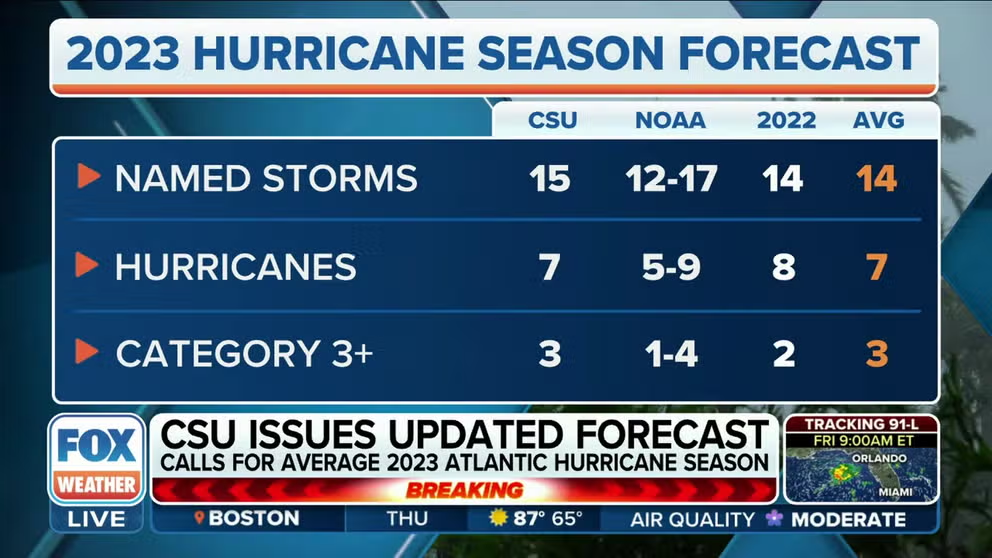What to expect in the tropics in June as Atlantic hurricane season begins
June is usually not very active in the tropics, any named storms that do form tend to occur close to the U.S., particularly in the Gulf of Mexico, the western Caribbean Sea and near the Southeast and mid-Atlantic coasts.
CSU now calls for near-average 2023 Atlantic hurricane season
Colorado State University increased its 2023 Atlantic hurricane season forecast on Thursday and now calls for a near-average season this year.
June 1 marks the official start of the Atlantic hurricane season, and while NOAA forecasters are expecting up to 17 named storms this year, the first month of the season tends to be slow.
The official Atlantic hurricane season runs until Nov. 30 because those six months account for about 97% of all tropical storms and hurricanes in the Atlantic Basin, which includes the Atlantic Ocean, Caribbean Sea and Gulf of Mexico.
However, the National Hurricane Center (NHC) says about 3% of Atlantic tropical cyclones occur before or after those dates, as we saw in eight of the past nine years, including 2023, when at least one tropical cyclone roamed the Atlantic before June 1.
FIRST STORM OF 2023 HURRICANE SEASON FORMED IN JANUARY, NHC SAYS
While the month of June is usually not very active in the tropics, any named storms that do form tend to occur close to the U.S., particularly in the Gulf of Mexico, the western Caribbean Sea and near the Southeast and mid-Atlantic coasts.
These storms typically track toward the north or northeast, which means the Gulf and Southeast coasts of the U.S. could potentially be in their path.

This map shows where tropical cyclone activity tends to occur during June. The data are shown as the combined number of tropical depressions, tropical storms and hurricanes whose centers pass within 125 miles of a point on the map during a 100-year period. The analysis is based on data from the 72-year period from 1950 to 2021 but normalized to 100 years.
(FOX Weather)
Between 1851 and 2020, only 6% of all tropical storms and 2% of all hurricanes roamed the Atlantic during June, according to data from NOAA's Atlantic Oceanographic and Meteorological Laboratory.
For comparison, September is the most active month of the Atlantic hurricane season and accounts for 40% of all tropical storms and 26% of all hurricanes on record.
WHERE TROPICAL STORMS, HURRICANES TYPICALLY OCCUR DURING EACH MONTH OF ATLANTIC HURRICANE SEASON
According to the NHC, June only averages one named storm in the Atlantic Basin each season, and it typically forms around June 20.

Each placemark denotes the location of a tropical depression, tropical storm or hurricane that formed in the Atlantic Basin during June between 1950 and 2021.
(FOX Weather)
Notable June hurricanes, tropical storms
The strongest storm to ever hit the U.S. in June was Hurricane Audrey on June 27, 1957, which crashed ashore in Cameron Parish, Louisiana, at Category 4 intensity on the Saffir-Simpson Hurricane Wind Scale.
HOW ARE HURRICANES RATED? THE SAFFIR-SIMPSON HURRICANE WIND SCALE EXPLAINED
Audrey's main impact was from an 8- to 12-foot storm surge that penetrated as far inland as 25 miles over portions of low-lying southwestern Louisiana. The NHC says the storm surge was responsible for the vast majority of the 390 deaths from Audrey. Damage from the hurricane in the U.S. was estimated at $150 million.
Tropical Storm Allison in 2001 was another tropical cyclone that brought significant impacts to the U.S. in June. Despite only being a tropical storm with winds around 50 mph at the time of landfall near Freeport, Texas, the remnants of Allison lingered over southeastern Texas for several days, spawning severe flooding in the Houston metro area.
The Port of Houston reported 36.99 inches of rain associated with Tropical Storm Allison. The storm was responsible for 41 deaths and at least $5 billion in damage. According to the NHC, Allison is the deadliest and costliest U.S. tropical storm on record.
Hurricane Agnes in June 1972 also caused major damage in parts of the U.S. Agnes made landfall in the Florida Panhandle on June 19, but the storm is remembered for its historic flooding in the Northeast and mid-Atlantic states in the days that followed.

The track of Hurricane Agnes in June 1972.
(FOX Weather)
Widespread rainfall totals greater than 10 inches were recorded from northern Virginia to the Finger Lakes of New York as Agnes stalled over the region for several days. According to NOAA's Weather Prediction Center, as much as 19 inches of rain was measured in western Schuylkill County in eastern Pennsylvania's Coal Region.
Agnes and its remnants were responsible for 122 deaths and $2.1 billion in damage in the U.S., mostly as a result of the historic flooding.
PEAK FLASH FLOOD SEASON IN U.S. BEGINS IN JUNE
The last time a hurricane made landfall in the U.S. in June was 36 years ago, when Hurricane Bonnie crashed ashore near High Island, Texas, on June 26, 1986. The National Weather Service says Bonnie didn't cause any major structural damage, but there was widespread minor damage reported, and debris littered the streets of Port Arthur and Beaumont, Texas.
There were no deaths directly attributed to Bonnie, according to the NWS, though there were four deaths indirectly related to the storm, including two in traffic accidents, one from a house fire and one who drowned while getting fresh water from a pond.
